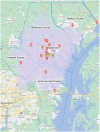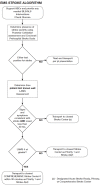The Maryland Acute Stroke Emergency Medical Services Routing Pilot: Expediting Access to Thrombectomy for Stroke
- PMID: 34539541
- PMCID: PMC8445030
- DOI: 10.3389/fneur.2021.663472
The Maryland Acute Stroke Emergency Medical Services Routing Pilot: Expediting Access to Thrombectomy for Stroke
Abstract
Background: Mechanical thrombectomy (MT) is the standard of care for acute ischemic stroke caused by large vessel occlusion, but is not available at all stroke centers. Transfers between hospitals lead to treatment delays. Transport directly to a facility capable of MT based on a prehospital stroke severity scale score has been recommended, if transportation time is less than 30 min. Aims: We hypothesized that an Emergency Medical Services (EMS) routing algorithm for stroke, using the Los Angeles Motor Scale (LAMS) in the field, would improve time from last known well to MT, without causing patients to miss the IV Thrombolysis (IVT) window. Methods: An EMS algorithm in the Baltimore metro area using the LAMS was implemented. Patients suspected of having an acute stroke were assessed by EMS using the LAMS. Patients scoring 4 or higher and within 20 h from last known well, were transported directly to a Thrombectomy Center, if transport could be completed within 30 min. The algorithm was evaluated retrospectively with prospectively collected data at the Thrombectomy Centers. The primary outcome variables were proportion of patients with suspected stroke rerouted by EMS, proportion of rerouted ischemic stroke patients receiving MT, time to treatment, and whether the IVT window was missed. Results: A total of 303 patients were rerouted out of 2459 suspected stroke patients over a period of 6 months. Of diverted patients, 47% had acute ischemic stroke. Of these, 48% received an acute stroke treatment: 16.8% IVT, 17.5% MT, and 14% MT+IVT. Thrombectomy occurred 119 min earlier in diverted patients compared to patients transferred from other hospitals (P = 0.006). 55.3% of diverted patients undergoing MT and 38.2% of patients transferred from hospital to hospital were independent at 90 days (modified Rankin score 0-2) (P = 0.148). No patient missed the time window for IVT due to the extra travel time. Conclusions: In this retrospective analysis of prospectively acquired data, implementation of a pre-hospital clinical screening score to detect patients with suspected acute ischemic stroke due to large vessel occlusion was feasible. Rerouting patients directly to a Thrombectomy Center, based on the EMS algorithm, led to a shorter time to thrombectomy.
Keywords: acute stroke; emergency medical services; healthcare delivery assessment; large vessel occlusion; mechanical thrombectomy; routing protocol.
Copyright © 2021 Haight, Tabaac, Patrice, Phipps, Butler, Johnson, Aycock, Toral, Yarbrough, Schrier, Lawrence, Goldszmidt, Marsh and Urrutia.
Conflict of interest statement
VU received funding from Genentech Inc for two unrelated studies. As site PI for the TIMELESS trial and as PI of the OPTIMISTmain trial. The remaining authors declare that the research was conducted in the absence of any commercial or financial relationships that could be construed as a potential conflict of interest.
Figures



References
LinkOut - more resources
Full Text Sources

